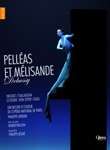|
Back
06/25/2013
Claude Debussy: Pelléas et Mélisande
Stéphane Degout (Pelléas), Elena Tsallagova (Mélisande), Vincent Le Texier (Golaud), Franz Josef Selig (Arkel), Julie Mathevet (Yniold), Anne Sofie von Otter (Geneviève), Jérôme Varnier (Shepherd, Doctor), Chœur de l’Opéra national de Paris, Patrick Marie Aubert (Chorus Master), Orchestre de l’Opéra national de Paris, Philippe Jordan (Conductor), Robert Wilson (Stage Director, Set and Lighting Designer), Giuseppe Frigeni (Co-Director), Frida Parmeggiani (Costume Designer), Heinrich Brunke (Lighting), Holm Keller (Dramaturgy), Philippe Béziat (Video Director)
A coproduction of the Opéra national Opera de Paris and Salzburger Festspiele, recorded live at the Opéra Bastille, Paris (March 2012) – 167’59
naïve # DR 2159 (distributed by Naxos of America) – Booklet in French and English – Subtitles available in French and English

   
If there’s one word to depict the common thread sewn into the Pelléas et Mélisande fabric of Maurice Maeterlinck’s play, Claude Debussy’s music and Robert Wilson’s staging, it would be “avant-garde.” Maeterlinck’s literary works, heavily tinted with reflections of the Symbolist movement, were particularly intriguing to Claude Debussy. The Frenchman gave great thought to Maeterlinck’s Pelléas et Mélisande, seeking to fractionalize Nature and Imagination with mystical proportions. The premiere on April 3, 1902 at the Opéra-Comique was not without its critics, but the drame lyrique also had its cadre of supporters including Debussy contemporaries Paul Dukas and Vincent d’Indy. Pelléas et Mélisande didn’t fall nicely into the musical status quo, but through time the public eventually warmed, placing it firmly in the operatic repertoire.
At first glance Robert Wilson’s Pelléas set may appear stark and a bit unimaginative, but the production mesmerizes especially with the stunning use of lighting, an element of intrinsic value for any staging, according to Wilson. On balance, the hues and tinctures transform ever so subtly. Thus, the five act opera moves in a fluid, satisfying continuum with facilitation by Philippe Jordan’s orchestral pacing. If props appear to have been omitted or minimized to extreme measure, that is exactly the point: doing more with less, placing more meaning to things on stage while stimulating the observer’s imagination to delve into the cerebral cores of the main characters. Vacuous spaces and economies in paraphernalia allow the audience to grab hold of the production with a certain sense of theatrical independence.
The center of the story revolves around a love triangle featuring three brilliant deliveries. Frida Parmeggiani envelopes Stéphane Degout’s Pelléas in a white Master of Ceremonies suit, a distant reminder of Joel Grey (though dressed in black) from Cabaret while Elena Tsallagova is a nuanced Audrey Hepburn look-alike, flowing in a beautiful bluish-gray satin gown. Their vocal outpourings are superb. Particularly poignant is Degout’s Act IV love declaration, “On dirait que ta voix.” Vincent Le Texier’s cold baritone register brings compelling and foreboding life to his character as the sinister Golaud.
“It’s all in the hands”...Wilson helps elucidate the principals’ inner feelings through quick snaps of the hands that coincide with Debussy’s sudden jerkiness in scoring. In this Pelléas et Mélisande cast members move in quasi-slow motion, never establishing physical contact with one another, making us mindful of L’Année dernière à Marienbad (1961) (Last Year at Marienbad.) Anne Sofie von Otter’s cameo appearance in Act I has her Geneviève coiffed like that of Beatrice Lillie from Thoroughly Modern Millie, her voice soft and warm while Julie Mathevet finishes off her notes with a buttery polish yet acting a bit goofy demonstrating jester-like affectations as Golaud’s son, Yniold. Franz Josef Selig’s bass range makes his Arkel one that is sage and comforter.
The beauty in Pelléas et Mélisande is that time is of no real importance and interpretations by directors are endless. This co-production under the Naïve label is refreshingly captivating and artistically rendered under Robert Wilson’s watch.
Christie Grimstad
|